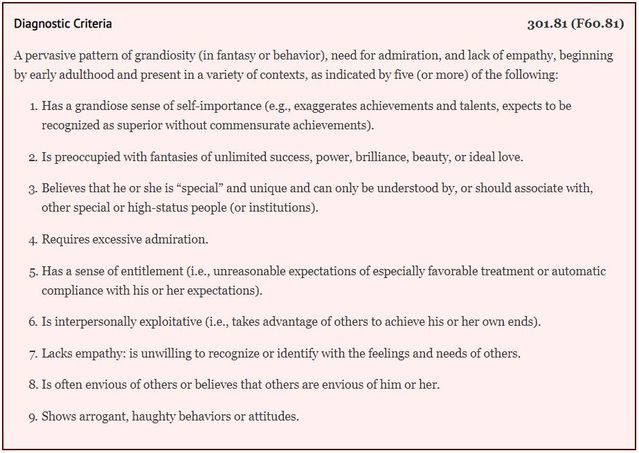Narcissism can be healthy when it's associated with balanced self-love, security, and self-esteem. Healthy narcissism means having a great relationship with oneself and not feeling ashamed of tending to oneself in special ways.Since narcissists deep down feel themselves to be faultless, it is inevitable that when they are in conflict with the world they will invariably perceive the conflict as the world's fault. — M. Scott Peck
Pathological Narcissism, On the Other Hand, Causes Problems
Per the DSM-5, Narcissistic Personality Disorder (NPD) is a long-standing pattern of "inner experience and behavior that deviates markedly from the expectations of the individual's culture," leading to "clinically significant distress or impairment in social, occupational, or other important areas of functioning." All personality disorders may affect 1) cognition, how we think and perceive ourselves, others and the world; 2) affectivity, how we experience and process emotions; 3) interpersonal functioning, the way we think, feel and behavior in relationships; and 4) impulse control. NPD, affecting 0.5 to 1 percent of the US population, the majority (50-70 percent) male, includes:

Grandiose Versus Vulnerable Narcissism
The construct of pathological narcissism overlaps with NPD. Two types of pathological narcissism are described: grandiose and vulnerable. Grandiose narcissism includes dominance, vengefulness, and a lack of regard for others' boundaries. Grandiose narcissists tend to have a thicker skin; deep down, if others don't like them, that's OK.
Vulnerable narcissism, on the other hand, hurts on the inside, and is more closely related to traditional psychoanalytic models of narcissism as covering up deep inner insecurity, a defensive response to difficulty coping with many of life's more difficult truths, especially regarding one's challenge areas. Often there is developmental trauma, leading some to call it "post-traumatic narcissism."
How Does Pathological Narcissism Affect Partners and Family Members?People with a healthy sense of self tend to avoid narcissism, especially the grandiose type, while sometimes compulsive caregivers will be drawn to vulnerable narcissists, who often need help but reject it.
The research on how pathological narcissism affects relationships is limited. Past work is with subgroups, such as college students, or looks at only one subtype, according to researchers Day, Bourke, Townsend, and Brin in their recent paper "Pathological Narcissism: A Study of Burden on Partners and Family."
They surveyed 683 participants who were in relationships with narcissistic folk. Sixty-two percent reported being with a narcissistic spouse or partner, 15 percent had been but were no longer, and 18 percent noted a family member, usually the mother (46 percent), or a sibling (16 percent), father (10 percent) or child (5 percent). They were compared people in relationships with close others with different conditions including other personality disorder (i.e. Borderline PD), depression, bipolar, anxiety disorders, and psychotic disorders.
Ages crossed the lifespan: participants averaged 44 years old, narcissistic people 48 years old, ranging from 20s to 60s. Participants were overwhelmingly female (94 percent), and, as expected, the close other usually male (77 percent).
Comment: Too bad there wasn't an equal representation of men in the study.
Measures: 1) the Pathological Narcissism Inventory (PNI); 2) the Burden Assessment Scale (BAS), measuring both pragmatic impact such as on money and time, as well as detriment to emotional state including distress and guilt; 3) the Grief Scale (GS), a way to estimate the sense of loss people experience from having close others with mental illness; 4) the Family Questionnaire (FQ), measuring how people cope in strained relationships, i.e. do they tend to be harsh and critical with others with mental illness; 5) the Mental Health Inventory-5 (MHI-5), looking at anxiety, depression, positive affect, loss of behavioral or emotional control, and psychological well-being; and, 6) the Perceived Burden Scale (PBS), measuring the objective burden in terms of how much the relationship gets in the way of other parts of their lives, personal and professional.
What Did We Learn About Living with Pathological Narcissism?
They found a higher burden for pathological narcissism than other personality disorders, mood or anxiety issues, or other psychiatric problems, with average reported burden 1.5 standard deviations higher. Higher burden scale scores were associated with greater grief, objective impact, and decreased mental health. Grief was associated with worse outcomes overall.
For Borderline Personality Disorder, only the material burden was similar to Narcissistic PD. Close others of those with personality disorders had diminished mental health. Nearly 70 percent scored consistent with a depressive disorder, and over 80 percent likely other mood and anxiety disorders.
Subtypes of pathological narcissism differently impacted participants. Narcissism was associated with greater grief, subjective and objective burden, but not worse mental health. Grandiose narcissism was associated with higher subjective and objective burden. By contrast, vulnerable narcissism was associated with increased grief.
Family members using negative coping styles reported greater grief, subjective and objective burden, and diminished mental health compared with those who coped more effectively. The biggest maladaptive coping mechanisms were criticism and emotional over-involvement. Relationship type made a difference; people with narcissistic partners/spouses reported greater negatives across the board.
Practical Implications and Future Directions
Key considerations come to mind. Most of the participants were women, the narcissistic others men. This makes sense given most were in heterosexual relationships, and more men are narcissistic. Future work could look at a larger sample of men with narcissistic others. Most of the family relationships were with narcissistic mothers, with implications for mother-daughter relationships.
Women with narcissistic mothers face particular difficulty. Their mothers may be more vindictive and blind to their daughters' needs, or distracted by their own insecurities and troubles. Future research looking at mother-daughter versus mother-son relationships would be of potential interest here.
Coping well is essential. Being critical and emotionally over-involved makes it worse. Being more compassionate and accepting, rather than critical, and maintaining appropriate boundaries and a separate sense of self, rather than being enmeshed and subject to emotional contagion, is protective. Future research could look at interventions to see what is most effective.
Given the high objective burden of being in a relationship with someone with pathological narcissism, adaptive action makes sense. These relationships drain resources, and interfere with other relationships and pursuits. Start by identifying which areas are hit the hardest. Spell it out, so you know where to focus your limited energy. Focus on outside relationships and carving out time for other pursuits.
This means extricating oneself from over-involvement. Learn to hit pause and come back later, rather than running away and getting sucked back in. It's OK to say "no" or "not now." Be consistent with boundary setting and recognizing one's own needs. Seeking professional assistance may be helpful, especially for people with dependency problems or the need to try to fix or rescue others. Staying with someone who is pathologically narcissistic is dangerous to one's health, emotionally and often physically. While guilt may keep us with vulnerable narcissists, hoping for change, it's important to know if the relationship is worth salvaging.
While this study did not look at physical well-being, it is likely that the stress and burden of living with pathological narcissism takes a toll. Potential hazards include impaired self-care, maladaptive coping with food, substances, alcohol, smoking and the like, and the loss of health-generating activities. Such relationships are more often associated with domestic violence and infidelity as well.
Being aware of the actual risks, getting past denial, and taking steps to secure one's well-being is crucial. For relationships where there is something of value, real love under the burden and grief, it's equally crucial to improve both relationship and individual quality of life despite the extra effort involved given the drain from pathological narcissism.
Resources
- Office on Women's Health: Domestic Violence Resources
- National Coalition Against Domestic Violence
- Mayo Clinic: Recognizing Domestic Violence Against Men
- The National Domestic Violence Hotline
About The Author
Grant Hilary Brenner, M.D., a psychiatrist and psychoanalyst, helps adults with mood and anxiety conditions, and works on many levels to help unleash their full capacities and live and love well.




I'm having a hard time understanding this. The study apparently merely went by the opinions of these participants about others with whom they associated. So we have no idea if ANY of the people were actually narcissists unless the 683 participants were mental health professionals who interviewed their spouse or partner or family members, made a diagnosis, and then told us what it was like to live with them.
Since narcissism has become a popular pejorative the study might tell us more about the participants than their supposedly narcissistic family members.